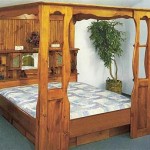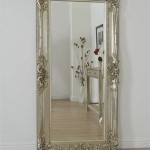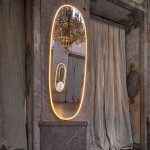How to Hang a Mirror on the Wall Without Nails
Hanging a mirror can significantly enhance the aesthetic appeal of a room, creating a sense of spaciousness and reflecting light to brighten the area. Traditionally, nails, screws, and other hardware requiring drilling have been the go-to methods for securing mirrors to walls. However, these techniques can cause damage to the wall surface, potentially requiring repairs later on. Furthermore, they might not be suitable for renters or those seeking a more temporary or less invasive hanging solution. Fortunately, there are several alternative methods available that allow for hanging a mirror without the use of nails, offering a damage-free and convenient option.
These nail-free methods rely on various adhesive technologies, designed to provide strong and reliable support for mirrors of different sizes and weights. The efficacy of each method depends on factors such as the weight of the mirror, the type of wall surface, and the environmental conditions of the room, such as humidity levels. Careful consideration of these factors is crucial for selecting the most appropriate and effective hanging solution to prevent accidents and ensure the longevity of the installation.
Before proceeding with any nail-free hanging method, it is imperative to prepare the wall surface properly. Cleaning the wall ensures optimal adhesion of the chosen adhesive materials. Dust, dirt, grease, or any loose particles can compromise the bond between the adhesive and the wall, leading to potential failure. Using a clean, damp cloth followed by a dry cloth to wipe the area where the mirror will be hung is generally recommended. For greasy surfaces, a mild detergent solution can be used, followed by thorough rinsing and drying. Allowing the wall to dry completely before applying any adhesive is crucial for achieving a strong and durable hold.
Additionally, it is important to assess the wall's paint condition. If the paint is peeling or flaking, the adhesive may bond to the loose paint rather than the wall itself, rendering the installation unstable. In such cases, it may be necessary to scrape off the loose paint and lightly sand the area to create a smoother surface for adhesion. Priming the exposed wall surface after sanding can further enhance adhesion and prevent damage to the underlying wallboard.
Using Command Strips
Command strips are a popular choice for hanging lightweight to medium-weight mirrors without nails. These adhesive strips are designed with a unique interlocking system that provides a strong and reliable hold, while also allowing for easy removal without damaging the wall. The key to successfully using Command strips lies in selecting the appropriate weight capacity for the mirror. Command strips are available in various sizes and weight ratings, and it is crucial to choose strips that can collectively support the mirror's weight with a safety margin. Overestimating the weight capacity is always advisable to prevent accidental falls.
The application process for Command strips is relatively straightforward. First, clean the wall surface as described previously. Then, separate the strips and attach them to the back of the mirror frame, following the manufacturer's instructions. Distribute the strips evenly across the frame to ensure balanced weight distribution. Press each strip firmly against the frame for the recommended duration, typically around 30 seconds. Next, carefully align the mirror with the desired position on the wall and press it firmly against the wall, ensuring that the strips adhere securely to the surface. Hold the mirror in place for the recommended amount of time, usually around one minute, to allow the adhesive to bond properly.
It is essential to allow the adhesive to cure for the specified period before fully releasing the mirror. This curing time typically ranges from one hour to 24 hours, depending on the specific Command strip product. Avoid applying excessive pressure or stress to the mirror during the curing process. Once the curing time has elapsed, the mirror should be securely mounted on the wall. To remove the mirror, carefully pull the Command strips downwards, as instructed on the packaging. The strips should stretch and release without damaging the wall surface. Any remaining adhesive residue can be easily removed with a clean cloth and rubbing alcohol.
Employing Mounting Tape
Mounting tape, also known as double-sided tape, is another viable option for hanging mirrors without nails. Similar to Command strips, mounting tape relies on adhesive technology to create a strong bond between the mirror and the wall. However, mounting tape typically comes in a roll and is cut to the desired length, offering greater flexibility in application. Choosing a high-quality mounting tape specifically designed for heavy-duty applications is crucial for ensuring a secure and long-lasting hold.
Before applying mounting tape, clean the wall surface thoroughly. Then, cut strips of mounting tape to the appropriate length and attach them to the back of the mirror frame. Space the strips evenly across the frame, paying particular attention to the corners and edges. Press each strip firmly against the frame to ensure a strong bond. Remove the backing from the mounting tape and carefully align the mirror with the desired position on the wall. Press the mirror firmly against the wall, applying even pressure across the entire surface.
The type of mounting tape used significantly impacts its effectiveness. Acrylic foam tape typically provides a stronger and more durable bond compared to rubber-based tape. Acrylic foam tape is also more resistant to temperature fluctuations and moisture, making it a suitable choice for bathrooms and other areas with high humidity. It is also crucial to note that some mounting tapes are permanent, meaning they cannot be removed without damaging the wall surface. Therefore, carefully consider the permanence of the installation before using mounting tape.
Leveraging Liquid Nails or Construction Adhesive
For heavier mirrors or situations requiring a more permanent and robust solution, liquid nails or construction adhesive can be used. These adhesives provide a very strong and durable bond, making them suitable for demanding applications. However, it is important to exercise caution when using these adhesives, as they can be difficult to remove and may cause damage to the wall surface if not applied carefully. It is recommended to use liquid nails or construction adhesive only when a permanent installation is desired and the potential for future removal is minimal.
Before applying liquid nails or construction adhesive, the wall surface must be clean and dry. It is also advisable to roughen the surface slightly with sandpaper to improve adhesion. Apply a thin bead of adhesive to the back of the mirror frame, following the manufacturer's instructions. Avoid applying too much adhesive, as it can squeeze out from the edges when the mirror is pressed against the wall. Position the mirror on the wall and press it firmly into place. Use shims or spacers to maintain the mirror's position while the adhesive cures.
Support the mirror during the curing process, which can range from 24 to 72 hours, depending on the specific adhesive product. This can be achieved by using painter's tape to secure the mirror to the wall or by propping it up with a piece of furniture. Once the adhesive has fully cured, remove the shims or spacers and inspect the installation. Liquid nails and construction adhesive can be very difficult to remove without damaging the wall, so ensure the placement is satisfactory before the adhesive sets completely. Clean any excess adhesive with a damp cloth while still wet.
Selecting the appropriate method to hang a mirror without nails involves carefully considering the mirror's weight, the wall surface, and the desired permanence of the installation. Command strips are suitable for lighter mirrors and offer easy removal, while mounting tape provides a stronger hold and greater flexibility. For heavier mirrors and permanent installations, liquid nails or construction adhesive offer the most durable solution. Proper wall preparation is crucial for ensuring optimal adhesion, regardless of the method chosen.

3 Simple Ways To Hang A Mirror On Wall Without Nails Wikihow

3 Simple Ways To Hang A Mirror On Wall Without Nails Wikihow

Hang Mirror Without Nail Or

3 Simple Ways To Hang A Mirror On Wall Without Nails Wikihow

How To Hang A Heavy Mirror In 5 Simple Steps

3 Simple Ways To Hang A Mirror On Wall Without Nails Wikihow

How To Hang A Mirror On Wall Without Nails

How To Put Mirrors On Walls Without Nails

How To Hang A Mirror On Wall Without Nails Guide For All Diyers

3 Simple Ways To Hang A Mirror On Wall Without Nails Wikihow








